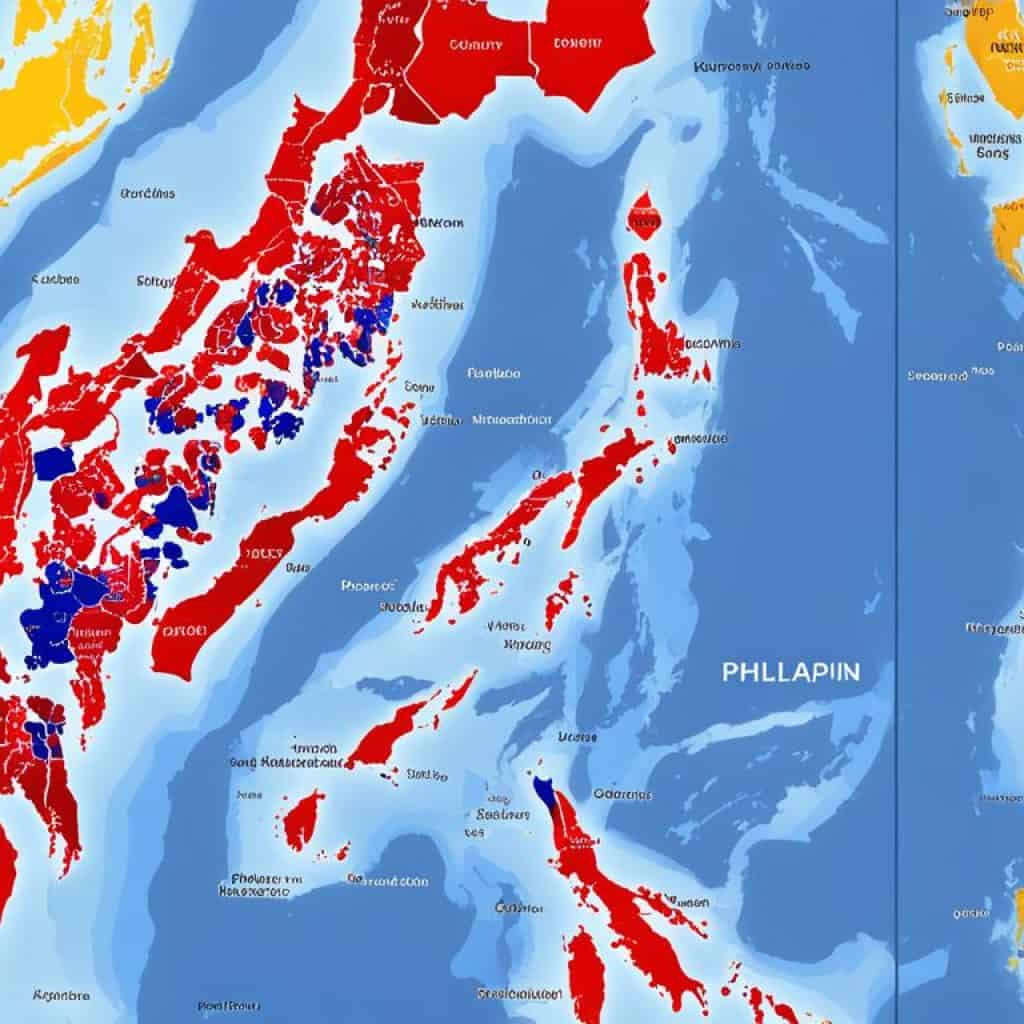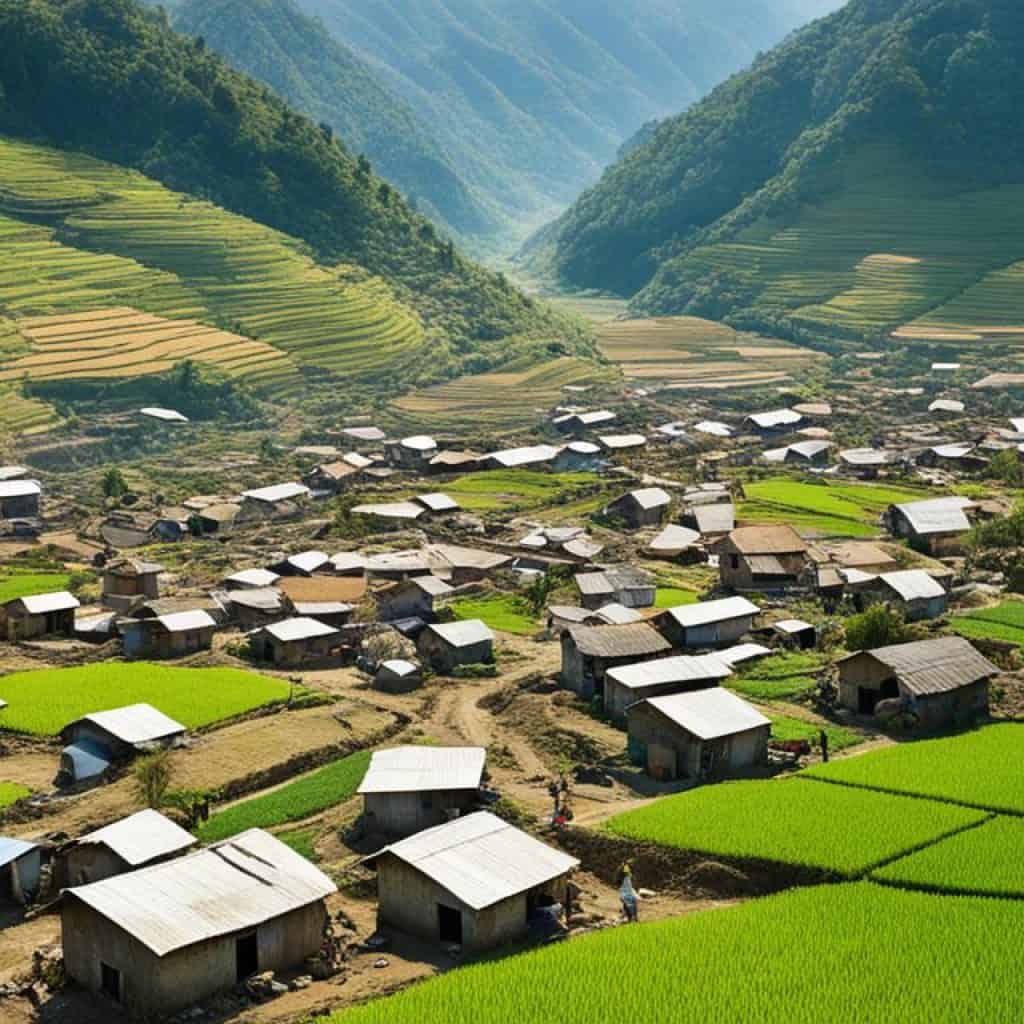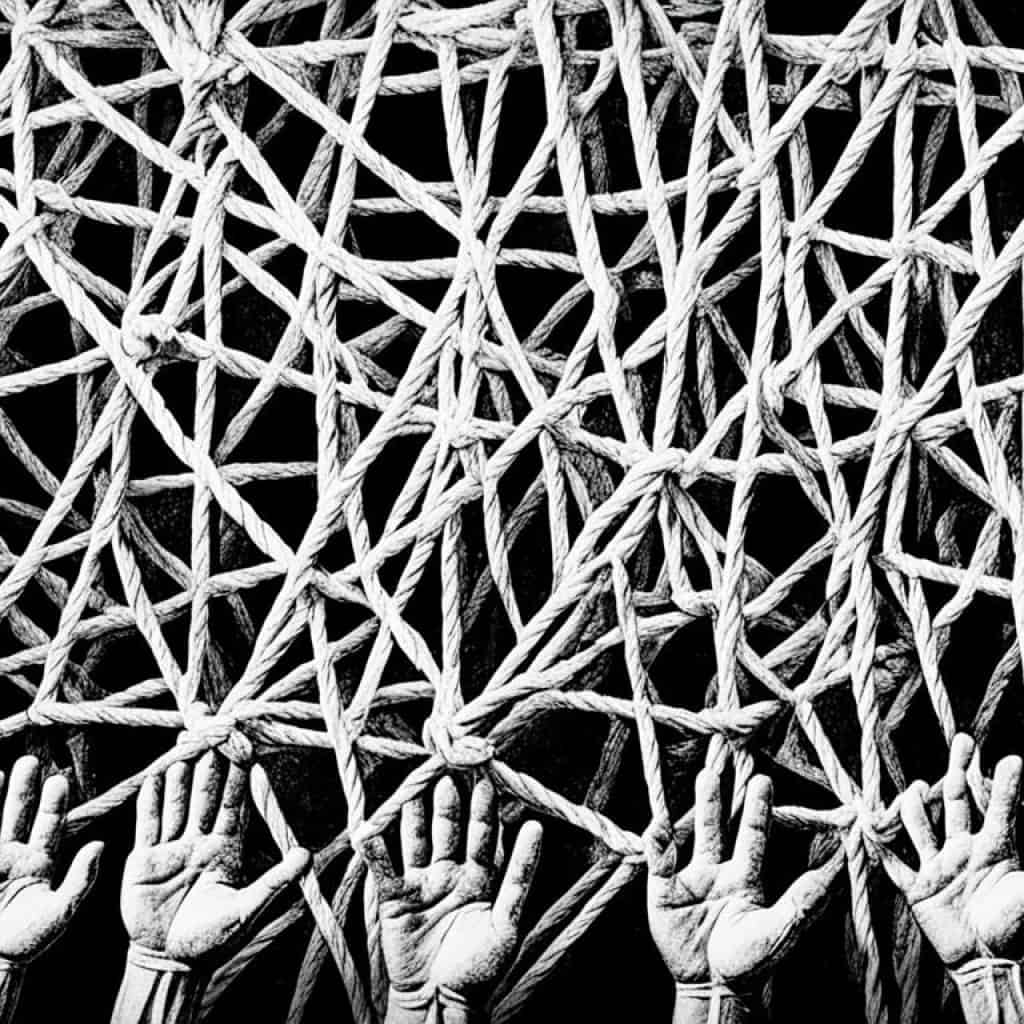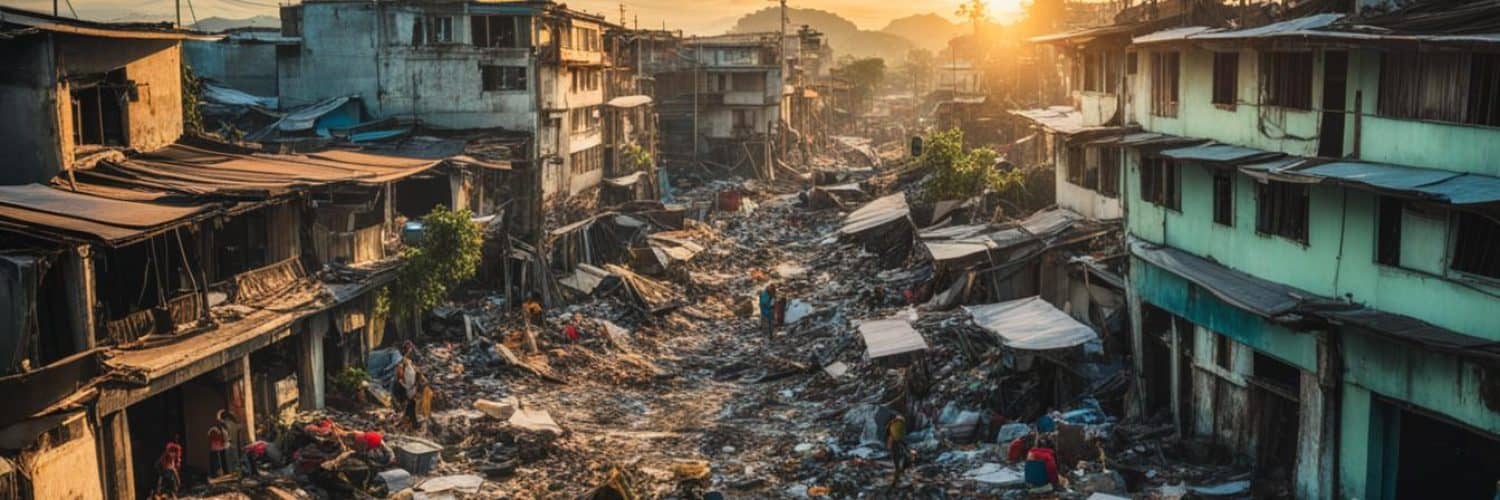How can the Philippines combat and end poverty by 2024? President Ferdinand R. Marcos Jr. has directed the Department of Social Welfare and Development (DSWD) to develop innovative programs to address this pressing issue. Through targeted initiatives and strategic policies, the government aims to uplift the lives of millions of Filipinos living in poverty.
Key Takeaways:
- The Philippine government has introduced the Food Stamp Program (FSP) and the Pantawid Pamilyang Pilipino Program (4Ps) to alleviate food poverty and provide education and healthcare subsidies to low-income households.
- The long-term vision, Ambisyon Natin 2040, guides the government’s efforts to end poverty in the Philippines by 2040.
- Rural areas in the Philippines face a higher prevalence of poverty, emphasizing the need for targeted interventions and rural economic development.
- Inclusive growth policies, investments in education, infrastructure, and job creation are crucial for reducing poverty rates and bridging the income gap.
- The government, along with NGOs and civil society, plays a crucial role in poverty alleviation by implementing programs and initiatives that address the root causes of poverty.
The Philippine Government's Long-Term Vision for Poverty Eradication
The Philippine government is committed to eradicating poverty in the country through its long-term vision, Ambisyon Natin 2040. This ambitious plan aims to create a prosperous society by 2040, where poverty is eliminated and the majority of the population belongs to the middle class.
Supported by the Asian Development Bank (ADB), the government has developed sustainable development goals and poverty eradication strategies that will guide all future development plans until 2040. These goals focus on inclusive growth, education, health, environment, governance, infrastructure, and energy.
By prioritizing inclusive growth, the government aims to ensure that the benefits of economic development are shared equitably among all segments of society. This includes creating more job opportunities, improving access to quality education and healthcare, and strengthening environmental conservation efforts.
“Our vision is to create a nation where no one is poor, where everyone has access to opportunities, and where the benefits of development are enjoyed by all.”
The government recognizes the importance of good governance and infrastructure in achieving sustainable development and poverty eradication. By implementing effective governance mechanisms and investing in critical infrastructure projects, the government aims to create an enabling environment for economic growth and social progress.
The Current State of Poverty in the Philippines
As of the latest Social Weather Station (SWS) survey, approximately 48% of Filipino families rate themselves as poor, highlighting the significant challenges the country faces in overcoming poverty. This equates to around 13.2 million families living in poverty, an increase from the estimated 12.5 million in June 2023.
Despite these alarming figures, there is a glimmer of hope. The survey also revealed that 25% of Filipino families consider themselves as “not poor,” showcasing a three-point increase compared to previous data. This suggests that efforts to alleviate poverty are yielding some positive results.
When examining poverty indicators, several factors come into play, including income inequality, geographic disparity, and family size. It is crucial to consider these elements to formulate effective strategies that will target the root causes of poverty in the Philippines.
“Poverty is not just a lack of income; it is a multidimensional issue that affects every aspect of a person’s life. By addressing the underlying factors that contribute to poverty, we can create a society that provides equal opportunities for all.”
One significant observation is that about 66% of the poor population resides in rural areas, underscoring the need for targeted interventions in these regions. These areas often face limited access to basic services and employment opportunities, exacerbating the challenges faced by those living in poverty.

| Income Inequality | Geographic Disparity | Family Size |
|---|---|---|
| Income inequality plays a critical role in perpetuating poverty, as it creates significant disparities in wealth distribution. | Geographic disparity refers to the unequal distribution of resources and opportunities between urban and rural areas. | Large family sizes can pose financial challenges, making it harder for households to meet their basic needs. |
The table above showcases three important poverty indicators: income inequality, geographic disparity, and family size. Understanding these indicators is crucial in formulating targeted and effective poverty alleviation strategies that address the unique challenges faced by different segments of the population.
By focusing on reducing income inequality, enhancing access to quality education and healthcare, promoting rural development, and empowering individuals and communities, the Philippines can work towards a future where poverty is significantly reduced, and everyone has equal opportunities to thrive.
Causes of Poverty in the Philippines
Poverty in the Philippines is a complex issue influenced by several factors that contribute to its persistence. These causes of poverty include:
- Economic inequality: The uneven distribution of benefits from economic growth widens the gap between the rich and the poor, leading to higher poverty rates.
- Limited access to education and healthcare: Lack of access to quality education and healthcare services hinders individuals from breaking the cycle of poverty and improving their overall well-being.
- Lack of employment opportunities: Insufficient job opportunities, especially in rural areas, result in high unemployment and underemployment rates, making it difficult for individuals to escape poverty.
- Natural or person-made disasters: The Philippines is prone to natural disasters such as typhoons and earthquakes. These calamities, coupled with the impact of human activities, disrupt livelihoods and exacerbate poverty levels.
Furthermore, larger family sizes also contribute to poverty challenges. With more members to support, purchasing power decreases, making it harder for families to meet their basic needs and achieve financial stability.
To address the causes of poverty in the Philippines, comprehensive poverty alleviation strategies are necessary. These strategies should aim to reduce economic inequality, improve access to education and healthcare, create employment opportunities, and enhance resilience to natural and man-made disasters. By targeting these underlying causes, the country can make significant progress in reducing poverty and improving the lives of its citizens.
Poverty Alleviation Programs and Initiatives
The Philippine government is committed to uplifting the lives of those in need through various poverty alleviation programs. These programs aim to reduce poverty rates, improve access to basic necessities, and create a more inclusive society. Among the key initiatives are:
- Food Stamp Program (FSP): The FSP provides subsidies for food to low-income households, ensuring that families have access to nutritious meals. This program helps alleviate food poverty and address malnutrition in the country.
- Pantawid Pamilyang Pilipino Program (4Ps): The 4Ps is a conditional cash transfer program that provides subsidies for education and healthcare to eligible households. By investing in human capital development, this program aims to break the cycle of poverty.
- Inclusive Growth and Rural Economic Development: The government recognizes the importance of inclusive growth in poverty reduction. Initiatives focusing on rural economic development, agricultural productivity, education, infrastructure, and job creation aim to bridge the income gap and uplift less fortunate communities.
These poverty alleviation programs and initiatives are designed to empower individuals, enhance livelihood opportunities, and create a more equitable society. By addressing the root causes of poverty and providing targeted support, the government is working towards building a brighter future for all Filipinos.
The Importance of Inclusive Growth in Poverty Reduction
Economic growth plays a crucial role in effectively reducing poverty rates. However, achieving sustainable and meaningful impact requires more than just overall economic expansion. Inclusive growth is the key to ensuring that the benefits of economic prosperity reach all segments of society, particularly those most affected by poverty.
To achieve inclusive growth, it is essential to prioritize expanding economic opportunities, especially in rural areas where poverty rates tend to be higher. This involves investing in sectors that have the potential to create decent jobs and empower less fortunate communities, such as agriculture, education, and infrastructure.
By prioritizing agricultural development, for example, we can improve farm productivity and income opportunities for rural households. This not only addresses income inequality but also enhances food security and reduces dependence on aid. Education is another critical sector that requires investment to empower individuals with the knowledge and skills needed to participate in the workforce and break the cycle of intergenerational poverty.
In addition, infrastructure development is crucial for inclusive growth as it facilitates access to markets, education, healthcare, and other essential services. By improving transportation networks, connecting remote communities to economic opportunities, and providing reliable access to electricity and clean water, we can bridge the income gap and uplift marginalized communities.
Benefits of Inclusive Growth:
- Reduces income inequality
- Promotes social mobility
- Improves access to basic services
- Enhances food security
- Creates sustainable jobs
- Empowers marginalized communities
It is important to recognize that inclusive growth is not a one-size-fits-all solution. Given the diverse landscape and unique challenges in the Philippines, targeted interventions and policies are necessary to address the specific needs of different regions and communities.
Inclusive growth ensures that economic prosperity is not confined to a select few but reaches the depths of society, leaving no one behind.
Through a comprehensive approach to poverty reduction that fosters inclusive growth, the Philippines can build a more equitable society, where economic opportunities are accessible to all and the cycle of poverty is broken. It is through this shared vision and collective effort that we can truly make a difference in the lives of those affected by poverty.
Addressing Poverty in Rural Areas
Rural areas in the Philippines are disproportionately affected by poverty, with approximately 66% of the poor population residing in these regions. To combat this issue, the government is committed to boosting rural economic opportunities through targeted initiatives that prioritize farm productivity and diversification.
By focusing on improving agricultural practices and supporting farmers, the government aims to create additional employment avenues and enhance the livelihoods of rural communities. These efforts are vital for reducing poverty rates and uplifting the economic well-being of residents in rural areas.
The government recognizes the importance of targeted interventions and investments in rural development. By providing access to resources, knowledge, and technology, the government empowers rural communities to overcome the challenges they face and create sustainable economic growth.
Through initiatives that promote rural entrepreneurship, encourage value chain development, and support diversification of economic activities, the government is working towards reducing the poverty gap between rural and urban areas.

The image above highlights the realities of poverty in rural areas and emphasizes the need for effective measures to address this pressing issue.
Government Investments in Rural Development
The government has allocated significant resources to support rural development and poverty reduction in these areas. This includes investments in critical infrastructure such as roads, irrigation, and connectivity to ensure that rural communities have access to essential services and markets.
Furthermore, programs focused on agricultural development, improving access to credit, and providing training and skills development opportunities for farmers are essential components of the government’s strategy for poverty alleviation in rural areas.
| Initiative | Description | Impact |
|---|---|---|
| Enhanced Agricultural Practices | Implementing sustainable farming techniques, promoting organic farming, and providing training in modern agricultural practices. | Increased productivity, improved crop yields, and higher income for farmers. |
| Rural Entrepreneurship Development | Supporting the establishment of small and medium-sized enterprises (SMEs) in rural areas, providing access to capital, business development services, and market linkages. | Creation of employment opportunities, economic diversification, and improved living standards in rural communities. |
| Infrastructure Development | Investing in infrastructure projects such as rural road networks, water supply systems, and electrification to enhance connectivity and access to essential services. | Improved accessibility, increased market access, and enhanced quality of life for rural residents. |
| Social Services and Education | Expanding access to quality education, healthcare facilities, and social services in rural areas to enable human capital development and improve overall well-being. | Empowering rural communities, reducing inequality, and promoting social inclusion. |
The table above highlights some of the key initiatives undertaken by the government to address poverty in rural areas. By implementing these strategies and investing in rural development, the government aims to create lasting positive change and improve the lives of those living in poverty-stricken rural communities.
The Need for Resilience Building in Poverty Alleviation
Poverty alleviation strategies must consider the need for resilience building among vulnerable households. This involves disaster preparedness, financial inclusion, and protection against market volatility. By building resilience, individuals and communities can better withstand economic and personal challenges, reducing the likelihood of falling back into poverty.
One key aspect of resilience building is disaster preparedness. Natural disasters such as typhoons, earthquakes, and floods can disproportionately affect those living in poverty. By implementing early warning systems, conducting evacuation drills, and providing emergency supplies and resources, governments and communities can minimize the impact of disasters on vulnerable populations.
Additionally, financial inclusion plays a vital role in resilience building. Access to affordable financial services, such as savings accounts, insurance, and microcredit, can help individuals and households manage financial shocks and cope with unexpected expenses. By promoting financial literacy and ensuring affordable and accessible financial services, governments can empower low-income individuals to build financial resilience.
Protection against market volatility is another essential component of resilience building. Economic fluctuations, price volatility, and job insecurity can have severe consequences for vulnerable communities. Governments can address these challenges by implementing social safety nets, such as cash transfer programs and unemployment benefits, to provide a financial buffer during periods of economic uncertainty.
To illustrate the importance of resilience building, consider the story of Maria, a single mother living in a coastal community. Maria’s resilience was put to the test when her community was hit by a typhoon. Thanks to the disaster preparedness training she received, Maria knew exactly how to evacuate with her children and seek shelter in a safe location. She had also been part of a village savings and loan association, which enabled her to access emergency funds to meet her family’s immediate needs. With the help of these resilience-building measures, Maria was able to rebuild her life and secure a more stable future for her children.
Overall, resilience building is a crucial component of poverty alleviation strategies. By providing safety nets, cash transfers, and insurance programs, governments can support vulnerable households and ensure their path towards economic stability. Disaster preparedness, financial inclusion, and protection against market volatility are essential pillars of resilience building that empower individuals and communities to overcome poverty’s challenges.
Multi-Faceted Approach to Poverty Mitigation
Addressing poverty requires a multi-faceted approach that acknowledges the dynamic nature of poverty and emphasizes inclusive growth across sectors and regions. By implementing a variety of poverty alleviation strategies, we can create a more equitable society where everyone has access to essential resources and opportunities.
Targeted Social Protection Programs
One crucial aspect of poverty alleviation is the implementation of targeted social protection programs. These programs, such as safety nets, cash transfers, and insurance programs, provide crucial support to the near-poor population. By offering financial assistance, social programs can help vulnerable individuals meet their basic needs and avoid falling deeper into poverty.
Inclusive Growth Policies
Inclusive growth policies play a vital role in poverty reduction by fostering economic development and bridging the income gap. These policies focus on various areas, including rural economic development, agricultural productivity, education, infrastructure, and job creation. By investing in these sectors, we can create opportunities for less fortunate communities and empower individuals to improve their socio-economic status.
Monitoring Poverty Dynamics
Continuously monitoring poverty dynamics is crucial for understanding the evolving nature of poverty and informing effective policy responses. Regular assessments allow policymakers to identify vulnerable populations and target interventions accordingly. By staying updated on poverty indicators, such as income inequality, geographic disparity, and family size, we can tailor poverty alleviation strategies to address specific needs.
Effective poverty mitigation requires a comprehensive approach that considers the unique challenges faced by individuals and communities. By combining targeted social protection programs, inclusive growth policies, and regular vulnerability assessments, we can work towards a more prosperous and equitable society.
Comparative Analysis of Poverty Alleviation Strategies
| Strategy | Description |
|---|---|
| Safety Nets | Provides immediate relief and support to individuals and families facing poverty |
| Income Generation Programs | Offers training and resources to help individuals generate sustainable income and escape poverty |
| Investment in Education | Improves access to quality education, leading to better job opportunities and higher earning potential |
| Rural Development Initiatives | Fosters economic growth in rural areas through agricultural support and infrastructure development |
| Microfinance Services | Provides financial services to individuals and small businesses, enabling them to start or expand their enterprises |
By adopting a multi-faceted approach that combines targeted social protection programs, inclusive growth policies, and monitoring poverty dynamics, we can make significant progress in poverty mitigation. It is through these collective efforts that we can create a society where every individual has the opportunity to thrive and overcome the challenges of poverty.
Government's Vision for a Poverty-Free Philippines
The Department of Social Welfare and Development (DSWD) envisions a poverty-free Philippines, where all citizens have equal access to opportunities in a fair, just, and peaceful society. The government’s mission is to lead in formulating, implementing, and coordinating social welfare and development policies and programs for the poor, vulnerable, and disadvantaged.
Through poverty eradication strategies, the government aims to create a more inclusive society, addressing the root causes of poverty and uplifting the lives of millions of Filipinos.
The Role of NGOs and Civil Society in Poverty Alleviation
Non-governmental organizations (NGOs) and civil society play a crucial role in implementing poverty alleviation strategies in the Philippines. These organizations collaborate with the government to target the most vulnerable populations and address their unique needs. By focusing on empowering communities, providing access to education, healthcare, livelihood opportunities, and social support, NGOs contribute to a holistic approach to poverty alleviation.
NGOs, such as Gawad Kalinga and World Vision, work tirelessly to uplift marginalized communities and provide them with the necessary tools and resources to escape the cycle of poverty. Through their programs and initiatives, they provide financial assistance, vocational training, and business mentorship to enable individuals to become self-sufficient and improve their quality of life.
Civil society organizations also play a crucial role in poverty alleviation efforts. These organizations act as advocates for vulnerable populations, drawing attention to their needs and amplifying their voices. They work with grassroots communities to address the root causes of poverty and develop sustainable solutions.
The work of NGOs and civil society in poverty alleviation is vital in complementing and supporting the government’s efforts. Together, they create a powerful force for change, driving progress and transforming the lives of millions of Filipinos.
Examples of NGOs and Civil Society Organizations
The Philippines is home to numerous NGOs and civil society organizations working towards poverty alleviation. Here are a few notable examples:
- Gawad Kalinga: A poverty alleviation movement that promotes community development through holistic programs focusing on housing, education, health, and livelihood.
- World Vision: An international NGO that prioritizes child sponsorship programs, education, healthcare, disaster response, and sustainable livelihood opportunities.
- Bantay Bata 163: A child welfare organization that focuses on rescuing and rehabilitating abused children, providing them with a safe environment and access to education and healthcare.
- The Philippine Business for Social Progress (PBSP): A network of businesses committed to poverty alleviation through various programs, including livelihood training, healthcare, and community development.
These are just a few examples of the diverse range of NGOs and civil society organizations actively working to mitigate poverty in the Philippines.

The Impact of NGOs and Civil Society
NGOs and civil society organizations provide crucial support to the government’s poverty alleviation efforts. Through their collaborative efforts, they are able to reach marginalized communities more effectively and tailor solutions to their specific needs. These organizations act as catalysts for change, empowering individuals and communities to break free from the shackles of poverty.
Moreover, NGOs and civil society organizations bring attention to the root causes of poverty and advocate for policy changes that address these underlying issues. They work to create an enabling environment where all individuals have equal access to opportunities and resources.
| Benefits of NGOs and Civil Society Organizations in Poverty Alleviation | Impact Areas |
|---|---|
| Promoting community empowerment | Empowering marginalized communities to become self-sufficient |
| Providing access to education | Ensuring children from low-income families receive quality education |
| Improving healthcare services | Working to enhance accessibility and affordability of healthcare for the underprivileged |
| Supporting livelihood programs | Equipping individuals with skills and resources to generate income |
| Advocating for policy changes | Addressing systemic issues and promoting inclusive policies |
The collective efforts of NGOs and civil society organizations are instrumental in achieving sustainable poverty reduction in the Philippines. By working hand in hand with the government and other stakeholders, they contribute to building a society where no individual is left behind.
Future Outlook for Poverty Reduction in the Philippines
The Philippine government is firmly committed to reducing poverty through the implementation of various programs and initiatives. By prioritizing inclusive growth, rural development, education, infrastructure, and job creation, the government aims to create a society free from poverty.
Continuous monitoring of poverty indicators and an understanding of poverty dynamics are crucial for policymakers to develop effective strategies to address the complex challenges of poverty. By analyzing and responding to poverty challenges, the government can refine existing programs and introduce new interventions to achieve sustainable poverty reduction.
The fight against poverty is a collective effort that requires the involvement of not only the government but also NGOs, civil society, and individuals. Collaboration and cooperation among these stakeholders are essential for maximizing the impact of poverty reduction initiatives and ensuring that no one is left behind.
By working together and implementing comprehensive poverty alleviation strategies, we can create a brighter future for the Philippines, where every citizen has equal opportunities and access to a better quality of life.
Key Points:
- The Philippine government is committed to reducing poverty through various programs and initiatives.
- Investing in inclusive growth, rural development, education, infrastructure, and job creation is crucial for poverty reduction.
- Continuous monitoring of poverty indicators and understanding poverty dynamics inform effective strategies.
- Collaboration among the government, NGOs, civil society, and individuals is vital for sustainable poverty reduction.
Conclusion
Addressing poverty in the Philippines requires a comprehensive and multi-faceted approach. By focusing on inclusive growth, poverty alleviation programs, rural development, resilience building, and policy interventions, the government is working towards a poverty-free Philippines by 2040. This vision reflects a commitment to uplift the lives of millions of Filipinos and create a society where no one is left behind.
Through targeted initiatives such as the Food Stamp Program (FSP) and Pantawid Pamilyang Pilipino Program (4Ps), the government aims to address the root causes of poverty and empower vulnerable communities. These programs provide subsidies for food, education, and healthcare, improving access to basic necessities and reducing poverty rates.
Furthermore, the government’s long-term strategies and investment in sectors like education, infrastructure, and job creation foster inclusive growth and bridge the income gap. By monitoring poverty indicators and understanding poverty dynamics, policymakers can develop effective strategies to combat the complex challenges of poverty.
With the collective efforts of the government, non-governmental organizations (NGOs), civil society, and individuals, the Philippines can progress towards sustainable development. By uplifting the lives of the Filipino people and creating equal opportunities for all, the country can build a poverty-free future in 2024 and beyond.
FAQ
What is the government doing to combat poverty in the Philippines?
The government has implemented various poverty alleviation programs such as the Food Stamp Program (FSP) and Pantawid Pamilyang Pilipino Program (4Ps). These initiatives provide subsidies for food, education, and healthcare to low-income households. In addition, the government focuses on inclusive growth, rural development, education, infrastructure, and job creation to bridge the income gap and uplift vulnerable communities.
What is the long-term vision of the Philippine government for poverty eradication?
The Philippine government’s long-term vision, Ambisyon Natin 2040, aims to end poverty in the country by 2040. This vision seeks to create a prosperous and predominantly middle-class society, ensuring that no one is left behind. All future development plans until 2040 will be aligned with this vision, ensuring consistent poverty eradication strategies.
What is the current poverty rate in the Philippines?
According to the latest Social Weather Station survey, approximately 48% of Filipino families rate themselves as poor, translating to around 13.2 million families living in poverty. This surpasses the estimated 12.5 million in June 2023. The survey also highlights that 25% of families consider themselves as “not poor,” indicating a three-point increase from previous data.
What are the main causes of poverty in the Philippines?
Poverty in the Philippines is influenced by various factors, including economic inequality, limited access to education and healthcare, lack of employment opportunities, and natural or man-made disasters. Uneven distribution of benefits from economic growth and larger family sizes also contribute to the persistence of poverty.
What are some of the poverty alleviation programs in the Philippines?
The Philippine government has implemented programs such as the Food Stamp Program (FSP) and Pantawid Pamilyang Pilipino Program (4Ps). The FSP provides a monthly meal augmentation worth PHP 3,000 to 1 million “food poor” families, while the 4Ps benefits 4.4 million households through subsidies for education and healthcare.
How does economic growth contribute to poverty reduction?
Economic growth plays a crucial role in poverty reduction. However, for sustainable impact, growth must be inclusive, benefiting all segments of society. Inclusive growth policies prioritize expanding economic opportunities, particularly in rural areas, and bridging the income gap. Investments in sectors like agriculture, education, and infrastructure are essential for creating decent jobs and empowering less fortunate communities.
Why is poverty more prevalent in rural areas in the Philippines?
About 66% of the poor population in the Philippines resides in rural areas. Limited access to education, healthcare, and employment opportunities in rural areas contribute to the higher prevalence of poverty. Additionally, challenges such as agricultural productivity, lack of infrastructure, and geographic disparity further exacerbate poverty in these regions.
How important is resilience building in poverty alleviation?
Resilience building is vital in poverty alleviation as it empowers vulnerable households to withstand economic and personal challenges, reducing the risk of falling back into poverty. Disaster preparedness, financial inclusion, and protection against market volatility are essential components of resilience building. Safety nets, cash transfers, and insurance programs offered by the government provide support to the near-poor and ensure their path towards economic stability.
What is the multi-faceted approach to poverty mitigation?
Addressing poverty requires a comprehensive and multi-faceted approach that considers the dynamic nature of poverty. It involves targeted social protection programs, inclusive growth policies, rural development, resilience building, and policy interventions. By understanding poverty indicators and regularly assessing vulnerability, policymakers can develop effective strategies to tackle the complex challenges of poverty.
What is the government’s vision for a poverty-free Philippines?
The government envisions a poverty-free Philippines, where all citizens have equal access to opportunities within a fair, just, and peaceful society. The government’s mission is to lead in formulating, implementing, and coordinating social welfare and development policies and programs for the poor, vulnerable, and disadvantaged. Through poverty eradication strategies, the government aims to create a more inclusive society, addressing the root causes of poverty and uplifting the lives of millions of Filipinos.
What is the role of NGOs and civil society in poverty alleviation?
Non-governmental organizations (NGOs) and civil society play a crucial role in poverty alleviation efforts. They collaborate with the government to implement programs and initiatives that target the most vulnerable populations. NGOs focus on empowering communities, providing access to education, healthcare, livelihood opportunities, and social support. Through their collective efforts, NGOs and civil society contribute to the holistic approach of addressing poverty in the Philippines.
What is the future outlook for poverty reduction in the Philippines?
The Philippine government’s commitment to poverty reduction is evident through the implementation of various programs and initiatives. By investing in inclusive growth, rural development, education, infrastructure, and job creation, the government aims to create a poverty-free society. Continuous monitoring of poverty indicators and understanding poverty dynamics will inform effective policy responses. The collective efforts of the government, NGOs, civil society, and individuals are vital for achieving sustainable poverty reduction.
Source Links
- https://reliefweb.int/report/philippines/govt-already-taking-strides-fight-against-hunger-and-poverty-sec-gatchalian
- https://www.adb.org/news/features/ambitious-vision-end-poverty-philippines-2040
- https://pia.gov.ph/press-releases/2024/02/02/pids-urges-targeted-policies-resilience-building-to-address-poverty














Add comment